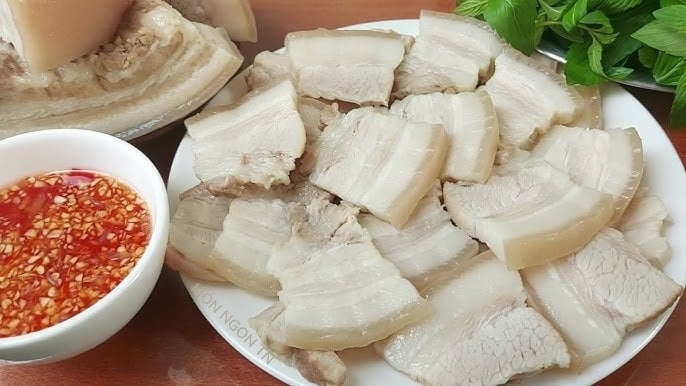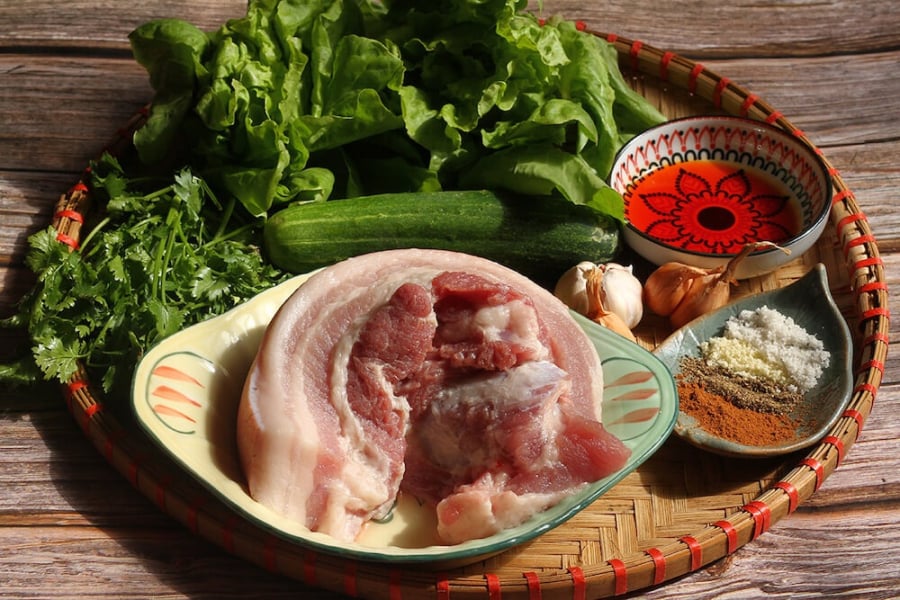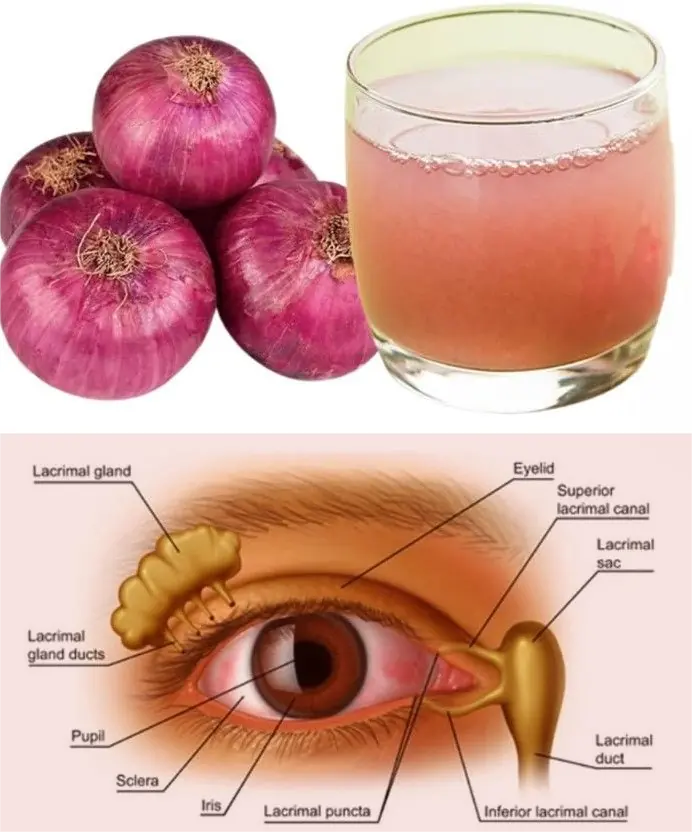
Boil pork that is both red and fishy: Drop this into the pot, the meat will cook evenly and release all dirt.

How to Boil Pork Perfectly: Spices and Tips for Tender, Fragrant, and Clean Meat
To create a truly delicious boiled pork dish, it’s not enough to just choose good-quality meat — the secret also lies in the spices you add to the pot. With the right ingredients, the meat will release impurities, lose its unpleasant odor, and turn out tender, juicy, and aromatic.
Essential Spices to Use When Boiling Pork
Below are some simple yet powerful ingredients that help remove impurities, eliminate odor, and elevate the flavor of your boiled pork to perfection.
1. Salt
After cleaning the pork and scraping away any remaining hair on the skin, rinse it under clean water. Then, rub salt evenly over the meat or wash it with a mixture of diluted saltwater.
If your meat cut is thick, consider splitting it into two pieces for even and faster cooking. Avoid cutting fresh pork into small chunks before boiling — doing so can cause the meat to shrink, dry out, and lose its natural sweetness.
When placing the meat into the pot, add a small pinch of salt to the water. This helps kill bacteria, draw out impurities, and subtly enhance the flavor of the pork.
2. Lemon Juice or Vinegar
Before boiling, soak the meat in diluted lemon juice or vinegar for about 15–30 minutes. This natural acid bath helps neutralize any unpleasant odor, remove slimy residue, and clean the meat thoroughly.
Not only does this step improve hygiene, but it also gives the final dish a cleaner taste and slightly firmer texture.
3. Ginger
Ginger is a well-known antibacterial spice that also removes the strong, meaty smell of pork. Add a few slices of crushed ginger into the boiling water — this will infuse a warm aroma and subtly sweet undertone, leaving the pork both fragrant and clean-tasting.
4. Onion and Garlic
Onion and garlic contain natural antimicrobial properties that help eliminate bacteria and impurities. Adding these to your boiling water not only cleans the meat but also imparts a richer aroma and deeper flavor.
You can lightly crush one onion and a few garlic cloves before tossing them in for best results.
5. Lime Leaves, Bay Leaves, or Coriander Roots
These aromatic herbs elevate your dish with their refreshing scent. They also help remove any lingering odor and enhance the pork’s natural sweetness.
Just a few lime leaves, bay leaves, or coriander roots in the pot can make a noticeable difference in flavor and presentation.
Bonus Tip: Double-Boiling for the Best Texture
For perfectly boiled pork, try using the two-step boiling method.
-
First boil: Place the pork in a pot of cold water, bring it to a simmer, and remove any foam or impurities that rise to the surface. Once the water boils, remove the meat and rinse it thoroughly under clean water. This step ensures all unwanted residues and odors are gone.
-
Second boil: Start again with fresh cold water. Add the cleaned pork along with a few slices of ginger, some scallions, and one crushed shallot. You can also sprinkle a pinch of salt for extra seasoning. Boil gently for about 20–25 minutes, depending on the thickness of the cut.
Remember to simmer over low to medium heat — boiling too vigorously can make the meat tough. The goal is to have pork that’s cooked through but still tender and juicy, with a delicate fragrance from the spices.
Choosing the Best Pork for Boiling
Selecting high-quality pork is just as important as cooking it properly. Here’s how to choose the freshest cuts:
-
Pick the right cut: Pork belly or leg cuts are ideal for boiling, as they contain both lean and fatty layers that stay moist and flavorful after cooking.
-
Check the color: Fresh pork should have a natural light pink to pale red hue. The fat should be white and slightly translucent. Avoid meat that looks dull, dark, or has an unnatural shine.
-
Examine the texture: Press gently on the meat — it should be firm yet elastic, bouncing back quickly when released. Avoid meat that feels sticky, slimy, or too soft.
-
Smell test: Fresh pork should have a neutral or mild aroma. If it smells sour, musty, or strange in any way, do not buy it.
-
Check the fat-meat ratio: A good piece of pork has a clear separation between fat and meat layers, but they should still adhere firmly to each other. Loose layers often indicate that the pork is old or of poor quality.
Final Notes
Once your pork is perfectly boiled, let it rest for a few minutes before slicing to retain its juices. You can serve it with a dipping sauce made from fish sauce, minced garlic, chili, and a few drops of lime juice for a bright, savory balance.
Boiled pork may seem like a simple dish, but when done right — with clean preparation, aromatic spices, and careful timing — it becomes a comforting, wholesome centerpiece for any family meal.
News in the same category


Why do we have to leave our phone face down on the table when we are not using it?

Hanging a towel on the door handle before bed: Unexpected benefits but few people know

Tips for conditioning your hair with over-cooked bamboo shoots

Treat premature gray hair thanks to the black dye formula

What Are These Strange Black Dots In Your Kitchen

Magic Eraser can be used for almost anything, but here's what you didn't know

Wrong understanding turns water purifiers into diseases, remove them immediately to avoid harming the whole family

The house is full of dust even though it is cleaned regularly

Pour hot water over the apple

It's rainy and humid, and there's no dryer at home. Do this to dry clothes quickly and keep them from smelling bad.

Add this one thing to cooked rice to make it 10 times more delicious and the nutritional value also increases many times.

Tell mom how to make standard, crispy and irresistibly delicious banh xeo

Stop ruining leftovers with these 10 mistakes

You're doing it all wrong. Here’s the right way to store tomatoes

You’re doing it all wrong. Here’s the right way to vacuum carpets

Most do this wrong. 10 plants you’re watering too often

Most don’t know. 12 brilliant ways to use WD-40 around the house

When frying lolot leaf patties, remember to take an extra step so the patties turn out fragrant, bright green, and not darkened.
News Post

Can Onion Juice Gently Support Eye Health? A Natural Tip to Try

Bed Bugs Hate This! How Diatomaceous Earth and Cloves Can Wipe Them Out

These are the consequences of sleeping with the…

5 Common Foods That Often Contain Parasites — Many People Eat Them Daily

1 Vitamin Stops Calcium Buildup in Arteries and Heart

S:ida Acuta: Exploring the Healing Properties of this Herbal Remedy

DIY Flaxseed Collagen Night Gel for Hydration and Rejuvenation

10-Day Licorice Treatment for Dark Spots: Fade Pigmentation and Achieve Glowing Skin Naturally

Easy Recipe to Make ABC Collagen Ice Cubes at Home: The Secret to Glowing, Firm Skin

2 Mins Black Shampoo For Grey Hair

Why this doctor refuses to prescribe statins for high cholesterol

The 'divine' secret to frying

Why do we have to leave our phone face down on the table when we are not using it?

Hanging a towel on the door handle before bed: Unexpected benefits but few people know

Tips for conditioning your hair with over-cooked bamboo shoots

Treat premature gray hair thanks to the black dye formula

What Are These Strange Black Dots In Your Kitchen

Magic Eraser can be used for almost anything, but here's what you didn't know

Wrong understanding turns water purifiers into diseases, remove them immediately to avoid harming the whole family
